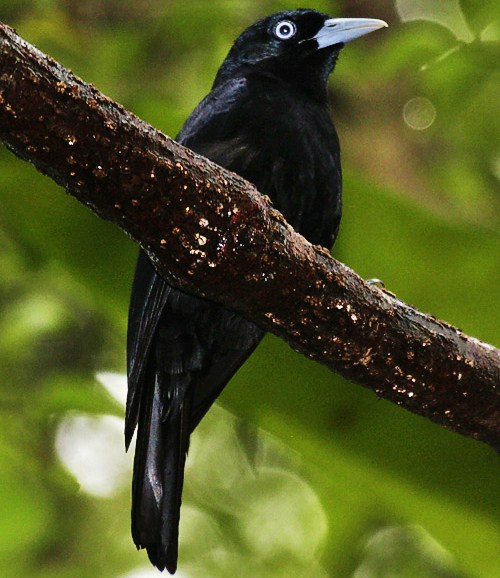Oriolia bernieri
 |
| Photo by Pete Morris (Surfbirds) |
Common name:
Bernier’s vanga (en); vanga-preto (pt); oriolie de Bernier (fr); vanga de Bernier (es); schwarzvanga (de)
Taxonomy:
Order Passeriformes
Family Vangidae
Range:
This species is endemic to Madagascar, being scarce and patchily distributed in the north-eastern parts of the island, between Marojejy and Zahamena.
Size:
This medium-sized vanga is 23 cm long and weighs 59 g.
Habitat:
The Bernier’s vanga is restricted to undisturbed, primary tracts of lowland humid evergreen forest.
Diet:
These birds mostly take large invertebrates, including beetles, crickets, cockroaches and spiders, but also geckos. They forage by searching the leaves and rooting around in the leaf-bases of pandanus Pandanus, ravenala Ravenala madagascariensis and palms, also levering rotten bark and moss off large tree-branches with its wedge-like bill.
Breeding:
Bernier’s vangas breed in August-November. Both sexes build the nest, a cup made of decomposed roots, palm fibres, dry leaves, and moss. There the female lays 3 eggs which are incubated by both parents for about 17 days. The chicks are fed by both parents and fledge about 17 days after hatching. The incubation and chick rearing duties may be shared between the breeding couple and young birds from previous clutches.
Conservation:
IUCN status – VU (Vulnerable)
This species has a small breeding range and a global population of 2.55-10.000 individuals. This population is suspected to be in decline owing to the clearance and degradation of forests within the species’s range. The principal threat to primary, lowland rainforest is posed by subsistence slash-and-burn cultivation, which results in progressively more degraded regrowth and leads eventually to bracken-covered areas or grassland. Much of the eastern coastal plain has either already been cleared or is covered by highly degraded forest, and the remaining habitat is under pressure from the increasing human population and commercial logging. If the present trends continue, the remaining forest (especially at lower altitudes) will disappear within decades.







